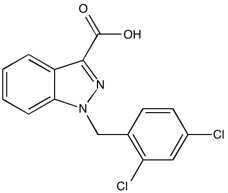Lonidamine | Inhibits Cancer Cell Metabolism
NMR (Conforms)

Available Options
| Size : | Price | Quantity | |
|---|---|---|---|
| 10 mg | $45.00 | ||
| 50 mg | $175.00 |
Lonidamine (50264-69-2) was originally investigated as an antispermatogenic agent.1 Lonidamine has been shown to decrease oxygen consumption as well as aerobic and anaerobic glycolysis in tumor cells leading to apoptosis.2 These effects have been attributed to the ability of lonidamine to inhibit mitochondrially bound hexokinase (IC50 = 90 μM for aerobic glycolysis, 45 μM for anaerobic glycolysis using Ehrlich ascites tumor cells)2. The apoptotic/antineoplastic effects of lonidamine have also been attributed to its ability to disrupt the mitochondrial transmembrane potential3 , intracellular acidification by inhibition of lactate efflux4 , and inhibition of the mitochondrial pyruvate carrier (MPC) and monocarboxylate transporter (MCT)5.
References/Citations:
1) Gatto et al. (2002), Recent studies on lonidamine, the lead compound of the antispermatogenic indazol-carboxylic acids; Contraception, 65 277
2) Floridi et al., (1981), Effect of Lonidamine on the Energy Metabolism of Ehrlich Ascites Tumor Cells; Cancer Res., 41 4661
3) Ravagnan et al. (1999), Lonidamine triggers apoptosis via a direct, Bcl-2-inhibited effect on the mitochondrial permeability transition pore; Oncogene, 18 2537
4) Ben-Horin et al. (1995), Mechanism of Action of the Antineoplastic Drug Lonidamine: 31P and 13C Nuclear Magnetic Resonance Studies; Cancer Res. 55 2814
5) Nath et al. (2016), Mechanism of antineoplastic activity of lonidamine; Biochim.Biophys.Acta Reviews on Cancer 1866 151
NMR (Conforms)
Safety Data Sheet:
Product Data Sheet:
Materials provided by Focus Biomolecules are for laboratory research use only and are not intended for human or veterinary applications. Please note that we do not sell to individuals and that all orders placed by non-research organizations will incur a $20 restocking/refund fee
Lonidamine (50264-69-2) was originally investigated as an antispermatogenic agent.1 Lonidamine has been shown to decrease oxygen consumption as well as aerobic and anaerobic glycolysis in tumor cells leading to apoptosis.2 These effects have been attributed to the ability of lonidamine to inhibit mitochondrially bound hexokinase (IC50 = 90 μM for aerobic glycolysis, 45 μM for anaerobic glycolysis using Ehrlich ascites tumor cells)2. The apoptotic/antineoplastic effects of lonidamine have also been attributed to its ability to disrupt the mitochondrial transmembrane potential3 , intracellular acidification by inhibition of lactate efflux4 , and inhibition of the mitochondrial pyruvate carrier (MPC) and monocarboxylate transporter (MCT)5.
References/Citations:
1) Gatto et al. (2002), Recent studies on lonidamine, the lead compound of the antispermatogenic indazol-carboxylic acids; Contraception, 65 277
2) Floridi et al., (1981), Effect of Lonidamine on the Energy Metabolism of Ehrlich Ascites Tumor Cells; Cancer Res., 41 4661
3) Ravagnan et al. (1999), Lonidamine triggers apoptosis via a direct, Bcl-2-inhibited effect on the mitochondrial permeability transition pore; Oncogene, 18 2537
4) Ben-Horin et al. (1995), Mechanism of Action of the Antineoplastic Drug Lonidamine: 31P and 13C Nuclear Magnetic Resonance Studies; Cancer Res. 55 2814
5) Nath et al. (2016), Mechanism of antineoplastic activity of lonidamine; Biochim.Biophys.Acta Reviews on Cancer 1866 151
Related Cancer Cell Metabolism Products
Download
Calculate the molar concentration, mass or volume in a solution.
Concentration × Volume × Molecular Weight = Mass
Focus Biomolecules • Plymouth Meeting, PA USA • 1-855-FOCUS21
Focus Biomolecules
Plymouth Meeting, PA USA
1-855-FOCUS21
Website Created by Advanta Advertising LLC.

